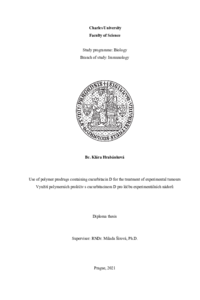Use of polymer prodrugs containing cucurbitacin D for the treatment of experimental tumors
Využití polymerních proléčiv s cucurbitacinem D pro léčbu experimentálních nádorů
diplomová práce (OBHÁJENO)

Zobrazit/
Trvalý odkaz
http://hdl.handle.net/20.500.11956/126253Identifikátory
SIS: 209351
Kolekce
- Kvalifikační práce [21483]
Autor
Vedoucí práce
Oponent práce
Grobárová, Valéria
Fakulta / součást
Přírodovědecká fakulta
Obor
Imunologie
Katedra / ústav / klinika
Katedra buněčné biologie
Datum obhajoby
1. 6. 2021
Nakladatel
Univerzita Karlova, Přírodovědecká fakultaJazyk
Angličtina
Známka
Velmi dobře
Klíčová slova (česky)
Nádorová onemocnění, imunoonkoterapie, cucurbitacin D, STAT3 signalizační dráha, MDSC, HPMA kopolymeryKlíčová slova (anglicky)
Cancer, immunooncotherapy, cucurbitacin D, STAT3 signalling pathway, MDSC;s HPMA copolymersChemoterapie je stále nejběžněji používaný typ protinádorové terapie. Většina chemoterapeutik obecně inhibuje proliferující buňky a necílí selektivně na nádorové buňky. Chemoterapie je spojena s vedlejšími účinky, které lze částečně omezit využitím polymerních nosičů konjugovaných s nízkomolekulárními léčivy. Vazba léčiva na polymer zlepšuje jeho rozpustnost ve vodných roztocích, snižuje systémovou toxicitu a pasivně jej cílí přímo do nádoru prostřednictvím efektu zvýšené propustnosti a retence. Práce je zaměřena na testování polymerních konjugátů založených N-(2-hydroxypropyl)methacrylamidu (HPMA) nesoucího cucurbitacin D (CuD), přirozeně se vyskytující sloučeninu s potenciální protinádorovou aktivitou. Mechanismus účinku dosud není objasněn, ale několik studií popisuje inhibici fosforylace a dimerizace signal transducer and activator of transcription 3 (STAT3) transkripčního faktoru, který je overexprimován u řady nádorových linií a hraje roli v diferenciaci myeloidních supresorových buněk (MDSCs). V této diplomové práci jsme zkoumali terapeutický účinek HPMA kopolymerů na bázi CuD v kombinované terapii s jinými polymerními chemoterapeutiky. Cytotoxický účinek polymerních konjugátů s CuD byl patrný in vitro u několika modelových nádorových linií. In vivo léčebné experimenty ukázaly, že kopolymery...
Chemotherapy is still the most widely used anti-cancer treatment. The majority of chemotherapeutics inhibit proliferating cells generally, not selectively cancer cells. The side effects associated with chemotherapy can be partly limited by conjugating a cytotoxic drug with a polymer nanocarrier. Such binding facilitates solubility in aqueous solutions, reduces systemic toxicity; and passively targets the drug directly into the tumour through the enhanced permeability and retention (EPR) effect. This thesis focuses on testing polymer conjugates based on N-(2-hydroxypropyl)methacrylamide (HPMA) carrying cucurbitacin D (CuD), a naturally occurring compound with potential anti-cancer activity. The mechanism of action is not elucidated yet, but several studies have depicted the inhibitory effect on signal transducer and activator of transcription 3 (STAT3) transcription factor. A STAT3 signalling pathway is overexpressed in several cancer cell lines and is also involved in the differentiation of myeloid- derived suppressor cells (MDSCs). We examined the therapeutic effect of the HPMA copolymers based on CuD in combined therapy with other polymer chemotherapeutics. CuD conjugates have shown in vitro cytotoxic effect on several model cancer cell lines. The combination with conjugates carrying doxorubicin...
